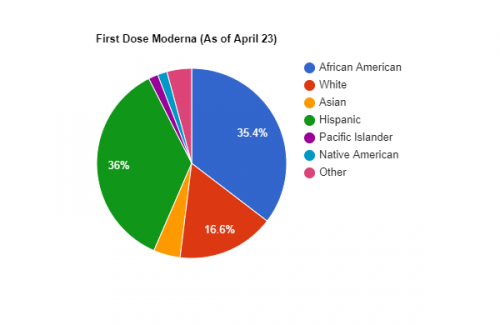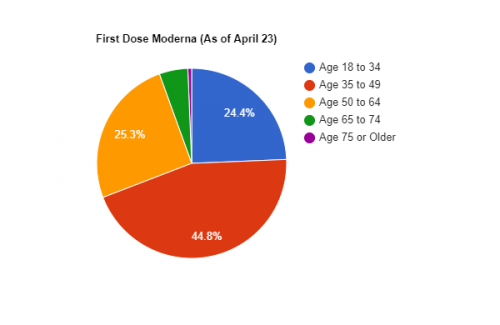
By Tiffany Devlin
Davis Vanguard’s bi-weekly update on Santa Rita Jail’s COVID-19 crisis. Click here for previous updates.
ALAMEDA, CA – During the months of April and May, Santa Rita Jail reported a handful of new COVID-19 cases among the incarcerated population and staff. Barring a few surges in cases, there have been no major outbreaks among residents or staff since January.
Currently, there are two positive cases among jail staff/contractors and none within the jail population.
In the past few weeks, the Alameda County Sheriff’s Office (ACSO) reported six new cases among the incarcerated population, five of which have either been released or resolved.
Weekly testing rates between April 20 and May 11 have been relatively low– ranging from thirteen percent to nine percent of the total population.
Vaccination Progress for Jail Population
ACSO began administering vaccinations to those with underlying medical conditions and comorbidities on March 1. Vaccinations have since expanded to other parts of the jail population.
As of May 7, 480 individuals were given the single dose Johnson & Johnson vaccine or both doses of the Moderna vaccine while in custody, of which 374 remain in custody. Currently, 17 percent of the jail population is fully vaccinated.
197 individuals received one dose of the Moderna vaccine while in custody, of which 167 remain in custody, i.e. about 7 percent of the jail population is currently partially vaccinated.
The Vanguard obtained a breakdown of vaccine uptake by ethnicity, gender and age as of April 23 from Mike Durbin, Health Services Administrator for Wellpath.
(Please see references section for the underlying data)
Ethnicity breakdown



Age breakdown

Gender breakdown
290 first doses and 210 second doses were given to males, while only 18 first doses and 15 second doses were given to females.
Community activists and organizers have argued that “distrust” in medical staff is a part of the reason incarcerated populations are hesitant to accept vaccines.
UCLA Law professor Dr. Shannon Dolovich describes this issue in her report, “Willingness to Receive COVID-19 Vaccination among Incarcerated or Detained Persons in Correctional and Detention Facilities — Four States, September–December 2020,” published in the April 2 issue of the CDC’s Morbidity and Mortality Weekly Report (MMWR).
According to Dolovich, more than three fourths of participants who reported they were hesitant to receive a COVID-19 vaccination indicated concerns about efficacy or safety. Many were also waiting to see others vaccinated.
In addition to this report, a survey developed by the Alameda County Public Health Dept. to track incarcerated people’s attitudes toward vaccinations and testing was offered on tablets and on paper between March 30 to April 2.
While the results are yet to be shared, Public Health has stated that there were around 60 viable responses.
ACSO and Wellpath have ceased reporting the number of individuals who have been offered vaccines due to potential duplicates. According to Mike Durbin, duplicates arise when individuals who previously declined a vaccine, request one at a later point. In response, the Vanguard argued that this data point is crucial to quantify vaccine hesitancy and devise solutions to improve uptake.
Residents in HU 1 ABCEF, HU 2-4, HU 6-9, HU 21 ADCEF, HU 24, HU 25, HU 31-34 have been offered vaccines thus far.
Since the population in these HUs changes frequently due to transfers, releases and intake, there may be new residents in these units who have not been offered the vaccine yet.
Vaccination Progress for Jail Staff
During a BOS meeting on March 16, Undersheriff Richard Lucia stated that “the data on vaccinations for employees of the Sheriff’s Office would be provided soon.” However, nearly 7 weeks later, this data is still pending.
Testing for Jail Staff
113 staff/contractor cases have been recorded since the pandemic emerged. 110 have recovered, leaving two active cases.
On March 1, the Alameda County Health Officer issued a mandatory testing order for all ACSO employees who work at SRJ after multiple failures from ACSO to comply with Public Health’s recommendation to test 100 percent of staff per month or 25 percent of staff per week.
ACSO provided its first summary report on April 12 to Public Health, detailing the implementation of the order and compliance for the month of March.
According to the report, staff cannot use tests other than the Simple HealthKit nasal PCR test to fulfill the mandatory testing requirement. Further, testing takes place within 14-day blocks– the first one was between March 14 and March 27 and the second took place between March 28 and April 10.
The total number of staff subject to testing under the order between March 28 and April 10 was 1,040. Of this total employee count, 35 were given valid exemptions due to “temporary reassignment outside of SRJ or extended time off,” according to the report. Other exemptions may include those who are lawfully entitled to a reasonable accommodation for a qualifying disability, medical restriction, or religious beliefs.
In the March 28 – April 10 block, 92 staff members were out of compliance with the order despite enforceable policy and a standardized testing schedule being in full effect. 913 staff complied with the order.
ACSO states that the list of employees out of compliance will be “provided to the Sheriff for his disposition.” According to the report, employees will be given a warning after the first instance of non-compliance, but subsequent failures to comply may result in administrative and/or criminal penalties.
No information has been provided on the number of penalties ACSO has given thus far.
The test itself is self-administered and may be observed by a supervisor to ensure proper compliance.
Between April 11 and April 24, it was reported that 828 ACSO SRJ staff were tested out of 1015, showing roughly an 82 percent compliance rate for the third testing block.
Despite testing being mandatory under the county health order, the compliance rate has fallen by 9 percent from the second to third block.
Kimi Watkins-Tartt, the director of the Public Health Dept. and the Board of Supervisors (BOS) have not raised concerns or presented new directives in light of the decreasing compliance rate. In a BOS meeting on April 27, community members argued that by failing to test 100 percent of staff, ACSO is in violation of the health order.
Additionally, ACSO failed to appear at two BOS meetings to present COVID-related updates for SRJ to the public.
ACSO will submit the next report on compliance and implementation to the Public Health Dept. on May 12.
It is important to note that the county health order only applies to ACSO staff who work at SRJ and not Wellpath’s medical staff assigned to the jail. When the Vanguard questioned if Wellpath would consider implementing a testing requirement for their employees that mirrors the Public Health Dept.’s order, Mike Durbin stated that they have no plans to do so. This is despite the fact that as of April 23, only 106 out of 135 full-time medical staff consented to taking a vaccine.
Testing for Jail Population
Since April 20, approximately 743 tests have been administered, of which 40 are pending results. Approximately 24 percent of the jail population was tested in the last two weeks and 14 percent in the past week.
There are no housing units undergoing surveillance testing, which may be contributing to the low weekly testing rates. In the past month, 56 percent of the entire jail population was tested.
Previously, the Vanguard uncovered that nearly 57 percent of new books at SRJ refused to be tested. As of April 23, the testing refusal rate for new books has dropped to 43 percent. For expanded testing, or testing conducted for patients with medical vulnerabilities, residents in open-air units, and pod workers (kitchen or laundry workers), the refusal rate is 88 percent.
For those awaiting release and transfer, however, the compliance rate for testing is 100 percent. Similarly, those housed in quarantine settings also had a 100 percent compliance rate.
In Santa Clara County’s jail system, testing for newly booked individuals is presented as a “required part of intake.” If the individual denies a test, they may be subjected to isolated housing, according to the jail’s intake protocol. This is contrast to the process at Santa Rita Jail, wherein new books are simply offered testing, without any consequence for not consenting.
While ACSO stated that they would explore more options to improve uptake for testing, community members and organizers have urged the Public Health Dept. to mandate testing during the booking process.
Medical Neglect
A recent investigation conducted by the Department of Justice’s Civil Rights Division concluded that SRJ’s use of prolonged restrictive housing, by which individuals have very limited out-of-cell time, is a violation of their Eighth and Fourteenth Amendment rights.
“Those with serious mental illnesses are subject to substantial risk of serious harm due to the jail’s use of restrictive housing,” reads the report on page 33.
The Vanguard recently reported on the suicide of Jonas Park, who was residing in HU 23– a COVID-19 quarantine housing unit for new books.
KTVU reported that residents in HU 23 are only allotted 30 minutes per day for recreational time, showering, or making phone calls.
Alameda County’s lawyer Gregory Thomas called the DOJ’s conclusions “stale information.” Thomas argues that because the last time the DOJ visited SRJ was in 2019, the criticism is outdated.
“I would like to see more attention and more services for the inmate population that has behavioral health issues,” Alameda County Sheriff Gregory Ahern said to KTVU, acknowledging that in addition to changes that have been made since the DOJ’s 2019 visit, there is room for improvement.
In addition to the DOJ’s findings, a state auditor pointed out that SRJ “lacks sufficient information” regarding mental illnesses within the incarcerated population.
“The auditing team found that deputies at Santa Rita only conduct mental health assessments of inmates who exhibit certain behaviors or disclose a history of mental illness to jail staff…” according to a KTVU report.
If all incarcerated people are not assessed, the jail cannot be sure that they are providing the mental health care that each individual needs. The state auditor recommended that SRJ immediately begin conducting mental health screening of all incarcerated people upon entering the jail.
Furthermore, Mike Brady, an independent consultant with Sabot Consulting which conducts periodic spot checks at SRJ, has expressed concern over the severe lack of mental health staffing in SRJ, acknowledging the negative impact it has on the jail population.
Brady also pointed out that during the pandemic, residents are getting limited out-of-cell time and structured programming time compared to pre-pandemic.
In response to Brady’s feedback, Capt. Luckett-Fahimi created a Behavioral Health Access Team (BHAT) consisting of three deputies, to organize group therapy with their service provider, Telecare.
As of late, Telecare conducts group therapy sessions in HU 9 during the week and HU 24 on the weekends. Telecare will provide additional group therapy sessions in HU 24 during the week in the future.
However, concerns regarding the lack of mental health clinicians at SRJ persist.
SRJ has one of the highest in-custody death rates in Northern California. From 2015 to 2019, at least 14 incarcerated people died by suicide. While community members argue that the impact of COVID-19 on this suicide rate is undeniable, the BOS and ACSO are reluctant to recognize a possible correlation.
Following the DOJ investigation, Decarcerate Alameda County, a local non-profit advocating for criminal justice reform, submitted a resolution to the BOS called the “Care First, Jails Last” to transform the county’s criminal justice system to one that prioritizes rehabilitation and healthcare.
The DOJ report revealed that approximately 40 percent of SRJ’s population is on the mental health caseload, and approximately 20–25 percent of the population has a serious mental illness.
The letter says, “the fundamental goal of a “Care First, Jails Last” policy is to develop a continuum of care that includes a full spectrum of treatment and housing, including preventative and outpatient services, inpatient acute and subacute facilities, licensed board and care homes, and other supportive options so that people with mental illness, substance use, and co-occurring disorders have a full opportunity to receive and live stable lives.”
Population Surges
The jail population has been fairly constant over the last few weeks, but has been on an upward trajectory since April 2020. Currently, there are 2146 people in custody.
In a recent video, Decarcerate Alameda County argued that SRJ and the District Attorney’s Office have not done enough to reduce the jail population during the pandemic.
While the population count fell in April 2020 through early-release programs and modified bail schedules, the jail has steadily been refilling its capacity.

Mike Brady of Sabot Consulting noted the significance of the Humphrey decision issued in March 2021, on SRJ’s population size. In reports following his fifth and sixth spot checks at the jail, Brady called upon the District Attorney, ACSO and Probation departments to find ways to control the rising population.
In re: Kenneth Humphrey, the California Supreme Court stated that it is unconstitutional to restrict an arrestee’s freedom from imprisonment based on their ability to afford bail.
“Following the mandate of the California Supreme Court should go a long way to reduce the inmate population in the SRJ… A smaller SRJ population will, on the natural, make it easier to follow the CDC guidelines on social distancing and space for medial isolation and medical quarantines.” Brady wrote in response to the Supreme Court opinion.
However, the Alameda County Superior Court has the discretion to enforce this new case law and consequently reduce SRJ’s population.
Concerns about the rising population have been amplified by the vaccine refusal rate. The low vaccine acceptance rate at SRJ– 17 percent, mirrors that of carceral facilities across the country. Brady warns in his reports that given the new virus variants and low vaccine acceptance, another surge in COVID-19 cases at SRJ is very much possible.
“I continue to urge the SRJ staff to work with the Alameda County Superior Court and its criminal justice partners to reduce the SRJ population. We are in a precarious position with vaccine refusal rates nationally and in California, and there are a number of virus variants, along with the economy opening back up, that may cause yet another surge,” Brady added.
To remedy the situation, Brady recommended that ACSO offer incentives for staff and incarcerated people to accept vaccines, such as more out-of-cell time, extra lunches, commissary credit, etc.
Housing Unit Quarantines
Between April 20 and May 11, a total of 11 housing pods were quarantined. These units were either quarantined for the second time in the last two months or re-quarantined since the pandemic emerged. Currently, all quarantines have been lifted.
Housing pods 35 A, B, and C underwent quarantine and surveillance testing from March 11 to April 14– nearly 35 days.
According to Lina Garcia-Schmidt, an SRJ Solidarity Hotline Coordinator, women residing in HU 35 have been unable to access cleaning supplies and sanitizing wipes since January due to disciplinary actions against them.
One woman in HU 35 requested sanitizing wipes on March 27 after her cellmate tested positive for COVID-19. She was told to wait until 6 p.m. to receive them.
Another HU 35 resident was told to not complain about her cold symptoms or she would be sent to the Outpatient Housing Unit.
In response to these allegations, Capt. Dan Brodie explained that he did not receive any reports from women in HU 35 about problems with lack of access to sanitizing supplies.
The SRJ Solidarity hotline received similar complaints from residents in HU 24. A woman named Stephanie Navarro stated that residents had not received clean clothing, sheets, or underwear in eight days.
Navarro also reported that a deputy was wearing a bandana instead of a mask, which failed to cover his nose and mouth.
References
Data on vaccinations for jail population:
Ethnicity breakdown:
- Out of 308 total first doses of Moderna, 109 were African American, 51 were White, 14 were Asian, 111 were Hispanic, 5 were Pacific Islander, 5 were Native American, and 13 identified as Other
- Out of 225 total second doses of Moderna, 75 were African American, 36 were White, 12 were Asian, 80 were Hispanic, 5 were Pacific Islander, 5 were Native American, and 12 identified as Other
Gender breakdown:
- 290 first doses and 210 second doses were given to males, while only 18 first doses and 15 second doses were given to females.
Age breakdown:
- 75 first doses and 43 second doses were given to people ages 18 to 34.
- 138 first doses and 110 second doses were given to people ages 35 to 49.
- 78 first doses and 61 second doses were given to people ages 50 to 64.
- 15 first doses and 11 second doses were given to people ages 64 to 74.
- Finally, two first doses were given to people 75 years of age or older.
(Contact apkomarla@ucdavis.edu to access underlying data through a comprehensive spreadsheet)
What is not clear, is/are the stats for the Mar/Apr period (2021), or cumulative since March 2020… that would be important information for a “reporter”… otherwise, the stats could be highly “skewed”… for whatever purpose… unknown…
Just looking for clarification, from the author of the piece… probably not a ‘happening thing’…
Which data point are you referring to exactly?
Hi Bill, feel free to send an email to apkomarla@ucdavis.edu if you’re looking for clarification on any data points.
Will do, tomrr0w or Friday… appreciate the invite to clarify without ‘the background noise’… that’s why I have hesitated to respond…
The ‘thing’ ‘happened’